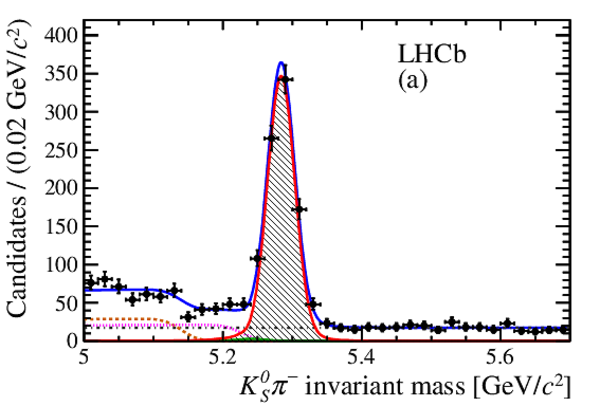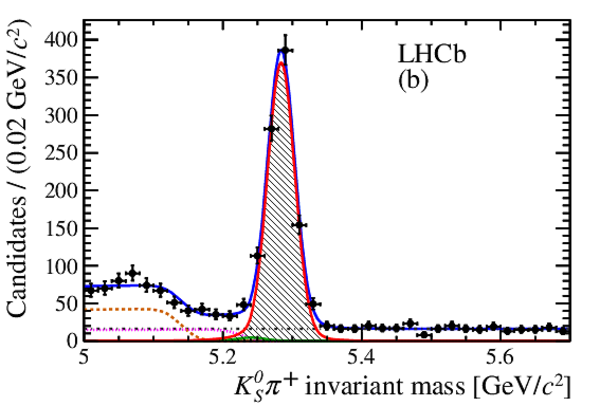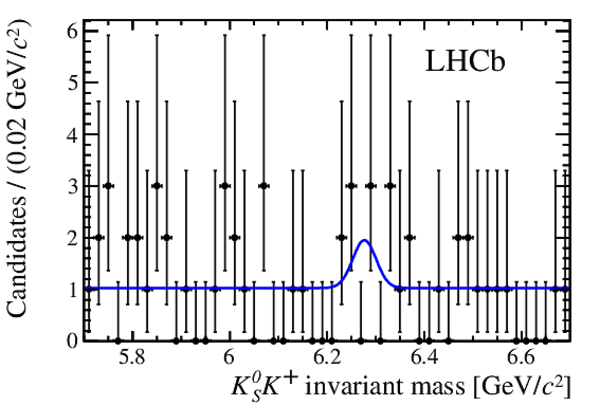Branching fraction and $CP$ asymmetry of the decays $B^+ \to K_{\rm \scriptscriptstyle S}^0 \pi^+$ and $B^+ \to K_{\rm \scriptscriptstyle S}^0 K^+$
[to restricted-access page]Information
LHCb-PAPER-2013-034
CERN-PH-EP-2013-147
arXiv:1308.1277 [PDF]
(Submitted on 06 Aug 2013)
Phys. Lett. B726 (2013) 646
Inspire 1246783
Tools
Abstract
An analysis of $B^+ \to K_{\rm \scriptscriptstyle S}^0 \pi^+$ and $B^+ \to K_{\rm \scriptscriptstyle S}^0 K^+$ decays is performed with the LHCb experiment. The $pp$ collision data used correspond to integrated luminosities of $1{ fb}^{-1}$ and $2{ fb}^{-1}$ collected at centre-of-mass energies of $\sqrt{s}=7\mathrm{ Te V}$ and $\sqrt{s}=8\mathrm{ Te V}$, respectively. The ratio of branching fractions and the direct {\it CP} asymmetries are measured to be $\mathcal{B}(B^+ \to K_{\rm \scriptscriptstyle S}^0 K^+)/\mathcal{B}(B^+ \to K_{\rm \scriptscriptstyle S}^0 \pi^+) = 0.064 \pm 0.009\textrm{(stat.)} \pm 0.004\textrm{(syst.)}$, $\mathcal{A}^{\it CP}(B^+ \to K_{\rm \scriptscriptstyle S}^0 \pi^+) = -0.022 \pm 0.025\textrm{(stat.)} \pm 0.010\textrm{(syst.)}$ and $\mathcal{A}^{\it CP}(B^+ \to K_{\rm \scriptscriptstyle S}^0 K^+) = -0.21 \pm 0.14\textrm{(stat.)} \pm 0.01\textrm{(syst.)}$. The data sample taken at $\sqrt{s}=7\mathrm{ Te V}$ is used to search for $B_c^+ \to K_{\rm \scriptscriptstyle S}^0 K^+$ decays and results in the upper limit $(f_c\cdot\mathcal{B}(B_c^+ \to K_{\rm \scriptscriptstyle S}^0 K^+))/(f_u\cdot\mathcal{B}(B^+ \to K_{\rm \scriptscriptstyle S}^0 \pi^+)) < 5.8\times10^{-2}\textrm{at 90% confidence level}$, where $f_c$ and $f_u$ denote the hadronisation fractions of a $\bar{b}$ quark into a $B_c^+$ or a $B^+$ meson, respectively.
Figures and captions
|
Invariant mass distributions of selected (a) $ B ^- \rightarrow K ^0_{\rm\scriptscriptstyle S} \pi ^- $ , (b) $ B ^+ \rightarrow K ^0_{\rm\scriptscriptstyle S} \pi ^+ $ , (c) $ B ^- \rightarrow K ^0_{\rm\scriptscriptstyle S} K ^- $ and (d) $ B ^+ \rightarrow K ^0_{\rm\scriptscriptstyle S} K ^+ $ candidates. Data are points with error bars, the $ B ^+ \rightarrow K ^0_{\rm\scriptscriptstyle S} \pi ^+ $ ( $ B ^+ \rightarrow K ^0_{\rm\scriptscriptstyle S} K ^+ $ ) components are shown as red falling hatched (green rising hatched) curves, combinatorial background is grey dash-dotted, partially reconstructed $ B ^0_ s $ ( $ B ^0$ / $ B ^+$ ) backgrounds are dotted magenta (dashed orange). |
cBmass[..].pdf [10 KiB] HiDef png [259 KiB] Thumbnail [218 KiB] *.C file |

|
|
cBmass[..].pdf [10 KiB] HiDef png [265 KiB] Thumbnail [221 KiB] *.C file |

|
|
|
cBmass[..].pdf [10 KiB] HiDef png [262 KiB] Thumbnail [219 KiB] *.C file |

|
|
|
cBmass[..].pdf [10 KiB] HiDef png [292 KiB] Thumbnail [239 KiB] *.C file |

|
|
|
(Left) Invariant mass distribution of selected $ B _ c ^+ \rightarrow K ^0_{\rm\scriptscriptstyle S} K ^+ $ candidates. Data are points with error bars and the curve represents the fitted function. (Right) The number of events and the corresponding value of $r_{ B _ c ^+ }$. The central value (dotted line) and the upper and lower 90% statistical confidence region bands are obtained using the Feldman and Cousins approach [37] (dashed lines). The solid lines includes systematic uncertainties. The gray outline of the box shows the obtained upper limit of $r_{ B _ c ^+ }$ for the observed number of 2.8 events. |
cBcMass.pdf [8 KiB] HiDef png [175 KiB] Thumbnail [159 KiB] *.C file |

|
|
limits[..].pdf [21 KiB] HiDef png [116 KiB] Thumbnail [64 KiB] *.C file |

|
|
|
Animated gif made out of all figures. |
PAPER-2013-034.gif Thumbnail |

|
Tables and captions
|
Corrections (above double line) and systematic uncertainties (below double line). The relative uncertainties on the ratio of branching fractions are given in the first column. The absolute corrections and related uncertainties on the $ C P$ asymmetries are given in the next two columns. The last column gathers the relative systematic uncertainties contributing to $r_{ B _ c ^+ }$. All values are given as percentages. |
[Error creating the table] |
Created on 27 April 2024.
